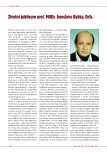Pathogenesis of type 1 and type 2 diabetes in 2011 – the unifying model of glucoregulation disorder
Authors:
J. Škrha
Authors‘ workplace:
III. interní klinika – klinika endokrinologie a metabolizmu 1. lékařské fakulty UK a VFN Praha, přednosta prof. MUDr. Štěpán Svačina, DrSc., MBA
Published in:
Vnitř Lék 2011; 57(11): 949-953
Category:
Birthday
Overview
Present knowledge on pathogenic mechanisms in type 1 and type 2 diabetes mellitus may offer the identical scheme of the cascade steps disturbing B-cell and its organells. The only one difference is based in the initiation of the whole cascade by cytokines activated in previous infection (Type 1 DM) or by increased concentration of free fatty acids (Type 2 DM) in the individuals with different genetic background for both types of diabetes. Impaired function and structure of mitochondria causes cell failure and its following apoptosis. The elucidation of the cause of changes in developed diabetes enables to suggest some perspective therapeutic approaches and/or preventive ways.
Key words:
type 1 diabetes mellitus – type 2 diabetes mellitus – pathogenesis – cytokines – free fatty acids – B-cell apoptosis
Sources
1. Moore F, Colli ML, Cnop M et al. PTPN2, a candidate gene for type 1 diabetes, modulates interferon-γ-induced pancreatic β-cell apoptosis. Diabetes 2009; 58: 1283–1291.
2. Colli ML, Moore F, Gurzov EN et al. MDA5 and PTPN2, two candidate genes for type 1 diabetes, modify pancreatic β-cell responses to the viral by-product double-stranded RNA. Hum Mol Genet 2010; 19: 135–146.
3. Florez JC. Newly identified loci highlight beta cell dysfunction as a key cause of type 2 diabetes: where are the insulin resistence genes? Diabetologia 2008; 51: 1100–1110.
4. Gurzov EN, Eizirik DL. Bcl-2 proteins in diabetes: mitochondrial pathways of β-cell death and dysfunction. Trends Cell Biol 2011; 21: 424–431.
5. Kim H, Tu HC, Ren D et al. Stepwise activation of BAX and BAK by tBID BIM, and PUMA initiates mitochondrial apoptosis. Mol Cell 2009; 36: 487–499.
6. Youle RJ, Strasser A. The Bcl-2 protein family: opposing activities that mediate cell death. Nat Rev Mol Cell Biol 2008; 9: 47–59.
7. Tait SW, Green DR. Mitochondria and cell death: outer membrane permeabilization and beyond. Nat Rev Mol Cell Biol 2010; 11: 621–632.
8. Eizirik DL, Mandrup-Poulsen T. A choice of death-the signal-transduction of immune-mediated β-cell apoptosis. Diabetologia 2001; 44: 2115–2133.
9. Van Raalte DH, Diamant M. Glucolipotoxicity and beta cells in type 2 diabetes mellitus: target for durable therapy? Diab Res Clin Pract 2011; 93 (Suppl 1): S37–S46.
10. Škrha J. Biochemie a patofyziologie. In: Škrha J (ed.). Diabetologie. Praha: Galén 2009: 33–76.
11. Allagnat F, Cunha D, Moore F et al. Mcl-1 downregulation by pro-inflammatory cytokines and palmitate is an early event contributing to β-cell apoptosis. Cell Death Differ 2011; 18: 328–337.
12. Zhou YP, Pena JC, Roe MW et al. Overexpression of Bcl-x(L) in β-cells prevents cell death but impairs mitochondrial signal form insulin secretion. Am J Physiol Endocrinol Metab 2000; 278: E340–E351.
13. Rieusset J. Mitochondria and endoplasmic reticulum: mitochondria-endoplasmic reticulum interplay in type 2 diabetes pathophysiology. Int J Biochem & Cell Biol 2011; 43: 1257–1262.
14. Drews G, Krippeit-Drews P, Düfer M. Oxidative stress and beta-cell dysfunction. Pflügers Arch – Eur J Physiol 2010; 460: 703–718.
15. Robertson RP, Harmon JS. Diabetes, glucose toxicity, and oxidative stress: a case of double jeopardy for the pancreatic islet beta cell. Free Rad Biol Med 2006; 41: 177–184.
16. Duchen MR. Contributions of mitochondria to animal physiology: from homeostatic sensor to calcium signalling and cell death. J Physiol 1999; 516: 1–17.
17. Škrha J jr., Gáll J, Buchal R et al. Glucose and its metabolites have distinct effects on the calcium-induced mitochondrial permeability transition. Folia Biol 2011; 57: 96–103.
18. Leloup C, Tourrel-Cuzin C, Magnan C et al. Mitochondrial reactive oxygen species are obligatory signals for glucose-induced insulin secretion. Diabetes 2009; 58: 673–681.
19. Anello M, Lupi R, Spampinato D et al. Functional and morphological alterations of mitochondria in pancreatic beta cells from type 2 diabetic patients. Diabetologia 2005; 48: 282–289.
20. Li LX, Skorpen F, Egeberg K et al. Uncoupling protein-2 participates in cellular defense against oxidative stress in clonal beta-cells. Biochem Biophys Res Commun 2001; 282: 273–277.
21. Produit-Zengaffinen N, Davis-Lameloise N, Perreten H et al. Increasing uncoupling protein-2 in pancreatic beta cells does not alter glucose-induced insulin secretion but decreases production of reactive oxygen species. Diabetologia 2007; 50: 84–93.
22. Scheuner D, Kaufman RJ. The unfold protein response: a pathway that links insulin demand with beta-cell failure and diabetes. Endocr Rev 2008; 29: 317–333.
23. Del Guerra S, Grupillo M, Masini M et al. Gliclazide protects human islet beta-cells from apoptosis induced by intermittent high glucose. Diabetes Metab Res Rev 2007; 23: 234–238.
24. Tankova T, Koev D, Dakovska L et al. The effect of repaglinide on insulin secretion and oxidative stress in type 2 diabetic patients. Diabetes Res Clin Prac 2003; 59: 43–49.
Labels
Diabetology Endocrinology Internal medicineArticle was published in
Internal Medicine

2011 Issue 11
Most read in this issue
- Antibiotic treatment of acute bacterial infections
- Management of obesity – options, effectiveness and perspectives
- Genetics of monogenic forms of diabetes
- Modern technologies in diabetology. CSII (Continuous Subcutaneous Insulin Infusion) and CGM (Continuous Glucose Monitoring) in clinical practice
